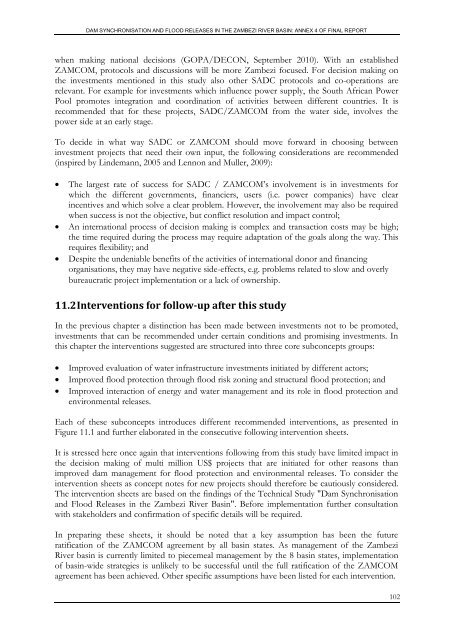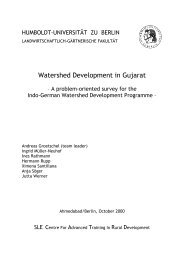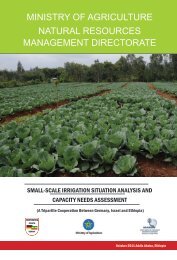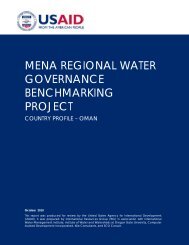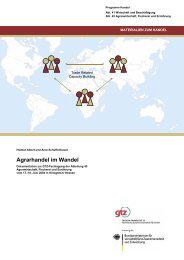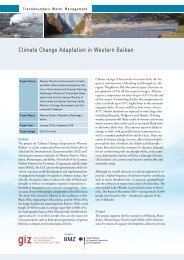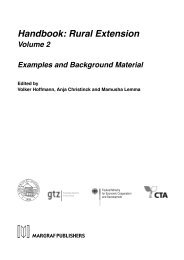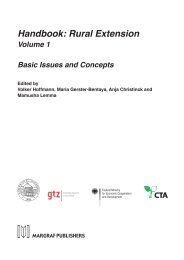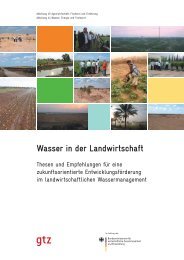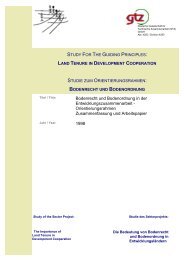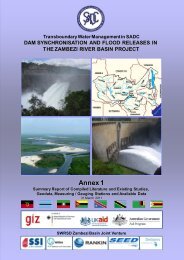Dam Synchronisation and Flood Releases - agriwaterpedia.info
Dam Synchronisation and Flood Releases - agriwaterpedia.info
Dam Synchronisation and Flood Releases - agriwaterpedia.info
You also want an ePaper? Increase the reach of your titles
YUMPU automatically turns print PDFs into web optimized ePapers that Google loves.
DAM SYNCHRONISATION AND FLOOD RELEASES IN THE ZAMBEZI RIVER BASIN: ANNEX 4 OF FINAL REPORT<br />
when making national decisions (GOPA/DECON, September 2010). With an established<br />
ZAMCOM, protocols <strong>and</strong> discussions will be more Zambezi focused. For decision making on<br />
the investments mentioned in this study also other SADC protocols <strong>and</strong> co-operations are<br />
relevant. For example for investments which influence power supply, the South African Power<br />
Pool promotes integration <strong>and</strong> coordination of activities between different countries. It is<br />
recommended that for these projects, SADC/ZAMCOM from the water side, involves the<br />
power side at an early stage.<br />
To decide in what way SADC or ZAMCOM should move forward in choosing between<br />
investment projects that need their own input, the following considerations are recommended<br />
(inspired by Lindemann, 2005 <strong>and</strong> Lennon <strong>and</strong> Muller, 2009):<br />
<br />
<br />
<br />
The largest rate of success for SADC / ZAMCOM‘s involvement is in investments for<br />
which the different governments, financiers, users (i.e. power companies) have clear<br />
incentives <strong>and</strong> which solve a clear problem. However, the involvement may also be required<br />
when success is not the objective, but conflict resolution <strong>and</strong> impact control;<br />
An international process of decision making is complex <strong>and</strong> transaction costs may be high;<br />
the time required during the process may require adaptation of the goals along the way. This<br />
requires flexibility; <strong>and</strong><br />
Despite the undeniable benefits of the activities of international donor <strong>and</strong> financing<br />
organisations, they may have negative side-effects, e.g. problems related to slow <strong>and</strong> overly<br />
bureaucratic project implementation or a lack of ownership.<br />
11.2 Interventions for follow-up after this study<br />
In the previous chapter a distinction has been made between investments not to be promoted,<br />
investments that can be recommended under certain conditions <strong>and</strong> promising investments. In<br />
this chapter the interventions suggested are structured into three core subconcepts groups:<br />
<br />
<br />
<br />
Improved evaluation of water infrastructure investments initiated by different actors;<br />
Improved flood protection through flood risk zoning <strong>and</strong> structural flood protection; <strong>and</strong><br />
Improved interaction of energy <strong>and</strong> water management <strong>and</strong> its role in flood protection <strong>and</strong><br />
environmental releases.<br />
Each of these subconcepts introduces different recommended interventions, as presented in<br />
Figure 11.1 <strong>and</strong> further elaborated in the consecutive following intervention sheets.<br />
It is stressed here once again that interventions following from this study have limited impact in<br />
the decision making of multi million US$ projects that are initiated for other reasons than<br />
improved dam management for flood protection <strong>and</strong> environmental releases. To consider the<br />
intervention sheets as concept notes for new projects should therefore be cautiously considered.<br />
The intervention sheets are based on the findings of the Technical Study "<strong>Dam</strong> <strong>Synchronisation</strong><br />
<strong>and</strong> <strong>Flood</strong> <strong>Releases</strong> in the Zambezi River Basin". Before implementation further consultation<br />
with stakeholders <strong>and</strong> confirmation of specific details will be required.<br />
In preparing these sheets, it should be noted that a key assumption has been the future<br />
ratification of the ZAMCOM agreement by all basin states. As management of the Zambezi<br />
River basin is currently limited to piecemeal management by the 8 basin states, implementation<br />
of basin-wide strategies is unlikely to be successful until the full ratification of the ZAMCOM<br />
agreement has been achieved. Other specific assumptions have been listed for each intervention.<br />
102


